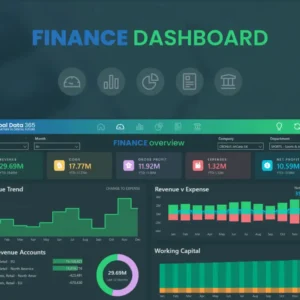Introduction
In today’s data-rich business environment, the ability to extract insights from information has become a critical competency. Microsoft Power BI is a leading analytics tool that empowers organizations to visualize and analyze data with ease, making it a valuable asset for businesses aiming to stay competitive.
However, adopting a new analytics platform can be a complex undertaking, requiring careful planning and strategy. This in-depth article aims to provide a comprehensive guide for organizations considering Power BI adoption, offering insights into key considerations, benefits, potential challenges, and actionable steps for a successful implementation.
Benefits of Adopting Power BI
Understanding the advantages of Power BI is the first step in appreciating its value as a business intelligence tool.
Data Visualization and Insights
Power BI offers robust data visualization capabilities, allowing users to create interactive and engaging reports and dashboards. It provides a wide range of chart types, maps, and custom visuals, enabling organizations to present complex data in a simplified and accessible manner. Through these visualizations, businesses can gain deeper insights, identify trends and patterns, and make more informed decisions.
Connectivity and Data Sources
One of Power BI’s strengths is its extensive connectivity options. It integrates seamlessly with various data sources, including Excel spreadsheets, on-premises databases, cloud-based services, and big data sources. This flexibility ensures that organizations can consolidate and analyze data from multiple systems, facilitating a unified view of their business operations and enabling data-driven decisions.
Self-Service Analytics
Power BI promotes a self-service analytics culture within organizations. Its user-friendly interface empowers business users to explore and analyze data independently, without relying heavily on IT or data experts. This democratization of data analytics fosters a data-driven mindset, enhances decision-making at all levels, and frees up technical resources for more specialized tasks.
Quick Insights and AI Integration
Power BI incorporates built-in AI capabilities that automatically suggest insights and trends from your data. The Quick Insights feature, for example, uses machine learning to identify patterns and relationships, providing instant insights without the need for manual analysis. This augmented analytics approach enhances the speed and accuracy of decision-making, giving businesses a competitive edge.
Scalability and Cost-Effectiveness
Power BI is designed to scale with your organization’s needs. Whether you’re a small business or a large enterprise, Power BI offers flexible licensing options and deployment models to suit varying requirements. Additionally, with Power BI, you can avoid costly infrastructure investments as it leverages the cloud for scalable and cost-effective data storage and processing.
Key Considerations for Adoption
Now that we’ve explored the benefits, let’s delve into the key factors to consider when adopting Power BI in your organization.
Assessing Business Needs and Goals
A clear understanding of your organization’s specific needs and goals is essential before implementing Power BI. Define the key performance indicators (KPIs) that are crucial for your business and identify the data sources that will provide actionable insights. By aligning Power BI’s capabilities with your unique requirements, you can ensure the platform delivers maximum value.
For example, a retail business may aim to improve inventory management and sales performance. By connecting Power BI to their point-of-sale systems, inventory data, and customer analytics, they can gain insights into product demand, optimize stock levels, and enhance overall sales performance.
Data Preparation and Governance
Effective data preparation and governance are critical to the success of any analytics initiative. Ensure that data is clean, consistent, and well-structured before importing it into Power BI. Define data ownership and establish data governance policies to maintain data quality and security.
Consider implementing data preparation tools and establishing data validation processes to ensure the accuracy and reliability of your analytics. Proper data governance also includes defining access controls and permissions to safeguard sensitive information.
Change Management and User Adoption
Implementing Power BI will likely involve a cultural shift within your organization. Change management plays a vital role in ensuring user adoption and minimizing resistance. Communicate the benefits of Power BI clearly and provide adequate training and support to users at all levels.
Encourage a data-driven mindset by showcasing how Power BI can streamline decision-making and improve overall business performance. Success stories and case studies from similar organizations can be powerful tools to drive user adoption.
Choosing the Right Deployment Model
Power BI offers two main deployment options: cloud-based and on-premises. The choice depends on your organization’s specific needs, data sensitivity, and existing infrastructure.
The cloud-based deployment leverages Microsoft’s Azure cloud platform, offering scalability, flexibility, and reduced IT overhead. This option is suitable for organizations seeking a cost-effective and rapidly deployable solution.
On the other hand, the on-premises deployment provides enhanced data security and control, making it ideal for organizations with strict data residency requirements or those wanting to leverage existing investments in local infrastructure.
Performance Optimization
Ensuring optimal performance is crucial for a positive user experience. Assess your data volume and complexity to determine the necessary hardware requirements, such as memory, processing power, and storage.
Additionally, consider implementing data compression and optimization techniques, especially when dealing with large datasets. Power BI also offers features like composite models and aggregations to improve query performance and reduce data load times.
Security and Compliance
Data security and compliance are critical considerations, especially when dealing with sensitive business information. Power BI provides robust security features, including data encryption, role-based access controls, and multi-factor authentication. Ensure that these security measures are properly configured and aligned with your organization’s data protection policies and industry regulations.
Regular security assessments and audits are essential to identify and mitigate potential risks. Stay updated with Power BI’s security enhancements and leverage its built-in monitoring tools for continuous oversight.
Integration with Existing Systems
Power BI’s strength lies in its ability to integrate with various systems and data sources. Assess your existing ecosystem and identify opportunities for integration. This could include connecting Power BI to your CRM, ERP, marketing automation platform, or other data sources to enable a holistic view of your business.
For example, integrating Power BI with Dynamics 365 can provide valuable customer insights, enabling sales and marketing teams to make data-driven decisions. Similarly, connecting it with an HR system can offer insights into workforce analytics, helping to optimize talent management strategies.
Building an In-House Power BI Expertise
While Power BI is designed for self-service analytics, building in-house expertise is crucial for more advanced use cases and to provide ongoing support. Invest in training and certification programs to develop a team of Power BI experts within your organization.
Microsoft offers a range of training resources, including online courses, workshops, and certification exams. Encouraging employees to pursue these certifications ensures a strong foundation for leveraging Power BI effectively and efficiently.
Implementation Steps
Now that we’ve covered the key considerations, let’s outline the practical steps for implementing Power BI in your organization:
Define Project Scope and Goals: Clearly define the scope and objectives of your Power BI implementation project. This includes identifying the specific business units or processes that will benefit from Power BI and setting measurable goals.
Assemble the Right Team: Bring together a cross-functional team with representatives from IT, data analytics, business operations, and other relevant departments. This team should have a mix of technical expertise and business acumen to ensure a successful implementation.
Data Preparation and Modeling: Clean, transform, and model your data to ensure it’s ready for analysis. Define the data sources, establish data pipelines, and implement data governance practices. Use Power BI Desktop to model and shape your data, creating a robust data model that forms the foundation of your reports and dashboards.
Report and Dashboard Design: Based on your defined KPIs and business requirements, design visually appealing and informative reports and dashboards. Utilize Power BI’s extensive visualization capabilities to create intuitive and interactive reports that provide actionable insights.
User Training and Onboarding: Provide comprehensive training and support to end-users to ensure they can effectively utilize Power BI. Offer a mix of tutorials, workshops, and ongoing support channels to facilitate user adoption and minimize resistance.
Rollout and Feedback Loop: Plan a phased rollout strategy to gradually deploy Power BI across your organization. Start with a pilot group, gather feedback, and iterate based on user insights. This approach allows for a smooth transition and ensures that the platform meets the needs of your users.
Monitor and Optimize: Continuously monitor Power BI’s performance and usage to identify areas for improvement. Leverage Power BI’s built-in monitoring tools, such as Power BI Premium capacity metrics, to optimize performance and resource allocation. Regularly review and refine your data models, reports, and dashboards to ensure they remain relevant and valuable.
Conclusion
Adopting Power BI can be a transformative journey for organizations, empowering them to unlock the value of their data and make informed decisions. While the process requires careful planning and consideration, the benefits of enhanced data insights, improved decision-making, and increased operational efficiency make it a worthwhile investment.
As you embark on your Power BI implementation, remember that it’s not just about the technology but also about fostering a data-driven culture and enabling your people to leverage the power of analytics.
What are your key considerations when adopting new technology like Power BI? How do you ensure a successful implementation and drive user adoption? Share your thoughts and experiences!







